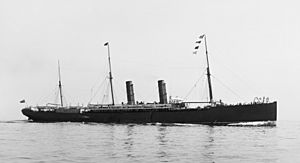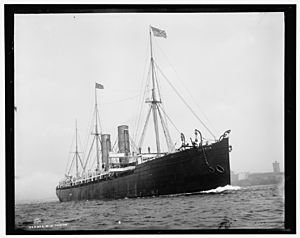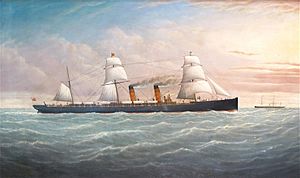SS Servia facts for kids
class="infobox " style="float: right; clear: right; width: 315px; border-spacing: 2px; text-align: left; font-size: 90%;"
| colspan="2" style="text-align: center; font-size: 90%; line-height: 1.5em;" | 
|} The SS Servia was a very important ocean liner that carried passengers and mail across the Atlantic Ocean. She was built by J & G Thomson in Scotland and launched in 1881. The Servia was special because she was the first large ocean liner made of steel instead of iron. She was also the first ship for the Cunard Line to have electric lights!
Contents
| History | |
|---|---|
| Name | SS Servia |
| Namesake | Servia, Greece |
| Owner | Cunard Line |
| Operator | Cunard Line |
| Port of registry | |
| Route | Liverpool – New York |
| Builder | J & G Thomson |
| Cost | £256,903 |
| Yard number | 179 |
| Launched | 1 March 1881 |
| Maiden voyage | November 26, 1881 |
| Homeport | Liverpool |
| Fate | Broken up in 1902 |
| General characteristics | |
| Type | Ocean liner |
| Tonnage | 7,392 GRT |
| Length | 515 ft (157 m) |
| Beam | 52.1 ft (15.9 m) |
| Draft | 40.75 ft (12.42 m) |
| Decks | 5 |
| Installed power | 10,300 ihp |
| Propulsion | Single Screw |
| Sail plan | Barque-rigged |
| Speed | 16.7 kn (best average) |
| Capacity | 480 1st class, 750 steerage |
| Crew | 298 |
Building a Better Ship
In 1878, the company that owned the Servia, which was then called Samuel Cunard's British and North American Royal Mail Steam Packet Company, changed its name to just Cunard. This change allowed them to get money from investors. With this new money, Cunard could build bigger and more expensive ships.
The Servia was launched on March 1, 1881. She was one of the largest ships in the world at the time. She was 515 feet long and 52.1 feet wide. Only two other ships were bigger: Brunel's SS Great Eastern and the SS City of Rome. The British Navy, called the Admiralty, helped design the Servia. This meant she had special features that could allow her to be used as a warship if needed. The ship was named after the historic English name for the country Serbia.
How the Servia Moved
The Servia's engine was very powerful. It was a compound steam engine that used steam to turn a single propeller. The steam came from seven large Scotch boilers. These boilers were 18 feet wide and had many furnaces to heat the water.
The engine produced 10,300 horsepower. This power allowed the Servia to reach a top speed of 17.85 knots during tests. On average, she sailed at about 16 knots. Even though she didn't set any speed records, the Servia was a very fast and reliable ship. In 1884, she crossed the Atlantic in less than seven days!
Special Features of the Servia
The Servia was different from older ships in many ways. She was one of the first ships designed mostly for passengers, not just cargo. At that time, other ships called tramp steamers were carrying most of the goods across the Atlantic. This meant the Servia could focus on taking people. Because of this, the Servia is seen as the first ship of the "Express Transatlantic Service." This was a new way of traveling quickly across the ocean.
The Servia also had many new technologies. Here are some of them:
How the Ship Was Built
The Servia was the first big ocean liner to be built using steel. Steel made the ship's body much stronger and lighter than iron. She also had a special "double-bottom" design. This meant she had two layers at the bottom of her hull, which could be filled with water to help balance the ship.
For safety, the Servia was divided into 12 separate, water-tight sections. If two of these sections filled with water, the ship could still stay afloat! The doors between the engine and boiler rooms could even be closed from other parts of the ship to prevent flooding.
Electric Lights on Board
The Servia was the first Cunard ship to have electric lights! Before her, a few other ships had small electric light systems. For example, the City of Berlin had six lights in 1879. Then, the Columbia had 200 lights in 1880, mainly in the main areas and first-class rooms.
When the Servia was finished in 1881, she had 119 incandescent light bulbs. Most of these were "Swan lamps." There were also two brighter "arc lamps." A special machine called a Siemens dynamo created the electricity. This electricity was sent through four separate circuits to light up the ship. Most of the lights were in the dining room, ladies' room, boiler rooms, engine room, and smoke room. Two lights were even used on deck to help load and unload cargo at night. The Edison and Swan Electric Light Company installed the lighting system. The Servia also had new types of compasses and devices to measure the depth of the ocean.
Passenger Comfort and Rooms
The Servia had very fancy and large public rooms for its time. On the top deck, there was a smoking room for men and a beautiful drawing room and music room for ladies. The main entrance and grand staircase were huge! They were made of shiny maple and ash wood. This staircase led down to a library on the main deck.
The Servia could carry 480 first-class passengers. The dining room could seat 220 people at five long tables. It was decorated with carved wood and nice carpets. In the middle of the dining room, there was an open space that went up 17 feet to a skylight, letting in lots of light.
On the lower deck, there were more first-class rooms. The front part of this deck was for 730 "steerage" passengers. These were people traveling in a more basic way. This area was very large and had its own dining space. The sleeping areas were separated for men and women.
What Happened to the Servia?
Later, in 1893, Cunard built even newer and faster ships like the RMS Campania and RMS Lucania. Because of this, the Servia was used for less important routes. She was also used to carry soldiers to South Africa during the Boer War. Finally, in 1902, the Servia was taken apart for scrap by a company called Thos. W. Ward.
Famous People on Board
Many interesting people traveled on the Servia:
- Writers Jane Addams and Henry James sailed on the Servia in August 1883.
- Edward Pellew, a British nobleman, and his wife sailed from New York City to Liverpool in October 1884.
- British writer Thomas Hughes, who wrote Tom Brown's Schooldays, was on board in October 1884.
- Industrialist Andrew Carnegie traveled with philosopher Herbert Spencer from Liverpool to New York in 1882.



